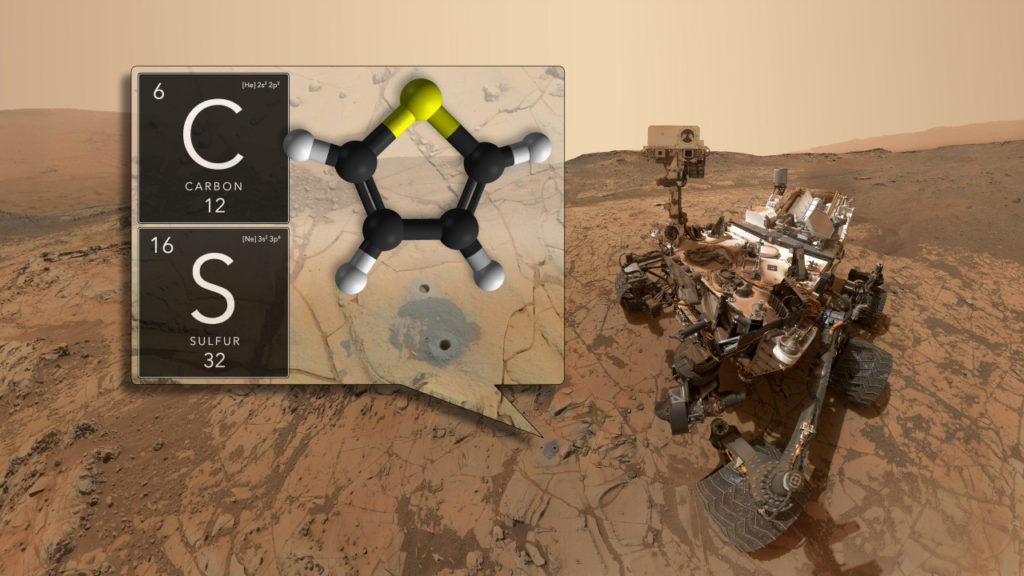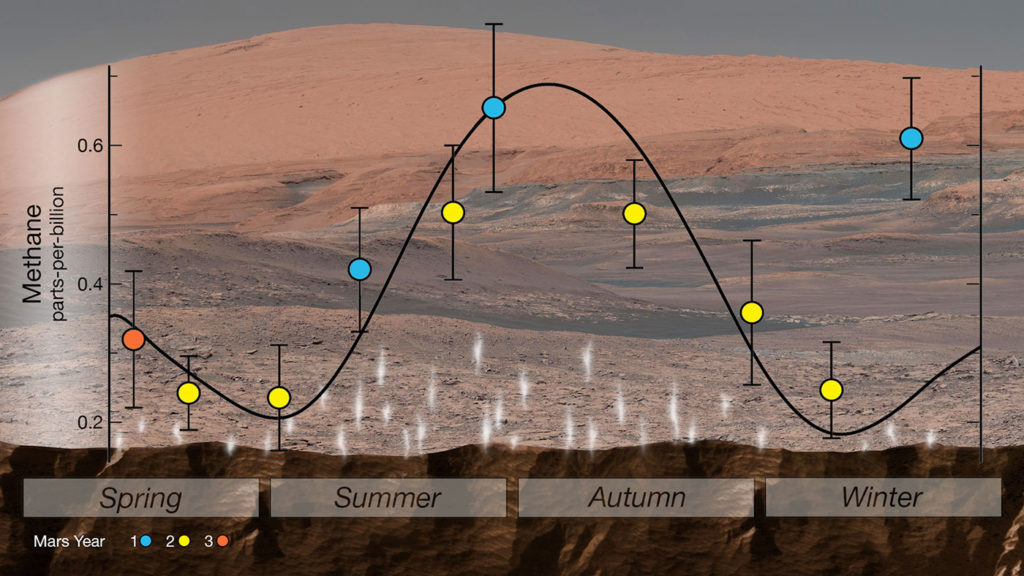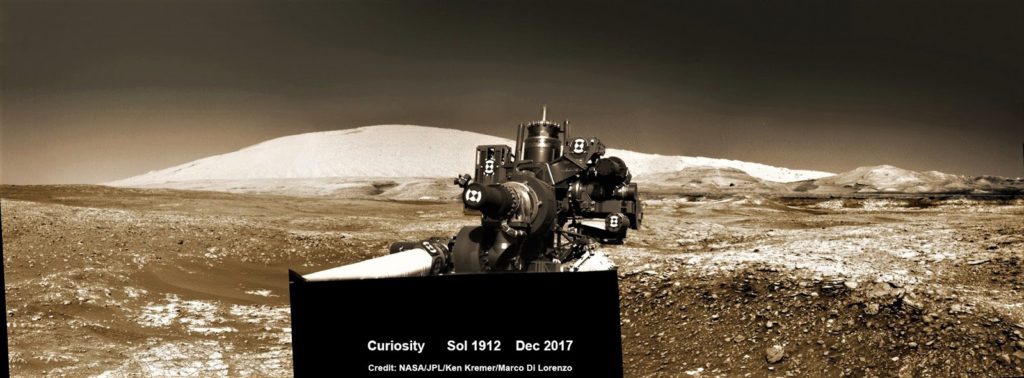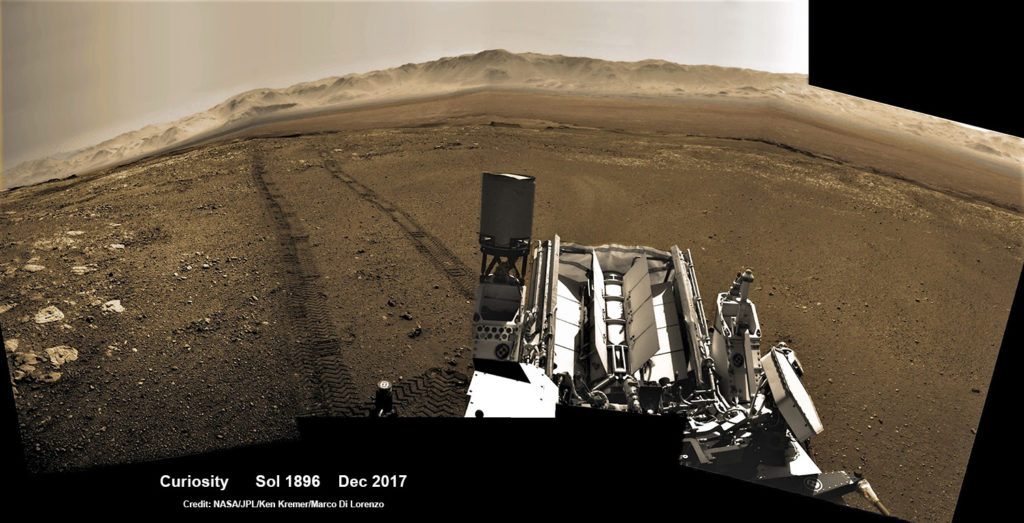June 2018
FL – NASA’s Curiosity rover has
discovered additional signs of habitability on Mars at the robots Gale Crater
landing site, both past and present in the form of organic molecules and gaseous
methane, that represent “breakthroughs in astrobiology,” researchers announced.
a variety of organic molecules including thiophene in ancient sedimentary rocks
as well as seasonal variations in the levels of methane in the atmosphere,
according to new findings announced at a NASA briefing as well as in new papers
published in the journal Science on June 8.
Curiosity onboard Sample Analysis at Mars (SAM) instrument suite researchers have provided “conclusive evidence for the
presence of organic compounds—thiophenic, aromatic, and aliphatic compounds—in
drill samples from Mars’ Gale crater,” in one of the newly published Science papers
by lead author Jen Eigenbrode, et al.
by lead author Chris Webster, et al, researchers report “a
strong seasonal variation in atmospheric methane, the simplest organic
molecule, in the martian atmosphere.”
in astrobiology,” writes Inge Loes
ten Kate, of Utrecht
University, Utrecht, Netherlands, in a third paper in Science.
prerequisites of life, although in and of themselves are not definitive proof
of life and can be created by non-biological
processes.
preserved in rocks on Mars that suggests the planet could have supported
ancient life, as well as new evidence in the Martian atmosphere that relates to
the search for current life on the Red Planet. While not necessarily evidence
of life itself, these findings are a good sign for future missions exploring
the planet’s surface and subsurface,” NASA said in a statement.
today, there is clear evidence that in the distant past, the Martian climate
allowed liquid water – an essential ingredient for life as we know it – to pool
at the surface. Data from Curiosity reveal that billions of years ago, a water
lake inside Gale Crater
held all the ingredients necessary for life, including chemical building blocks
and energy sources.”
has detected other chlorinated organics and signs habitability in past
findings, these new discoveries significantly expand the scope, variety and
complexity of the organics.
ancient lakebed,” said Jen Eigenbrode, a research scientist at NASA’s Goddard Space
Flight Center in Greenbelt, Maryland. “Those organic
molecules could have come from life.”
data by drilling into sedimentary “mudstone” rocks from four locations in Gale
Crater that formed billions of years ago “from silt that accumulated at the
bottom of the ancient lake” and analyzing them with the SAM instrument.
Fahrenheit (500 degrees Celsius) and thereby release the organic molecules in
gaseous form from the powdered rock.
concentrations on the order of 10 parts per million or more. This is close to
the amount observed in Martian meteorites and about 100 times greater than
prior detections of organic carbon on Mars’ surface. Some of the molecules
identified include thiophenes, benzene, toluene, and small carbon chains, such
as propane or butene.”
containing chlorine in rocks at the deepest point in the crater. This new
discovery builds on the inventory of molecules detected in the ancient lake
sediments on Mars and helps explains why they were preserved.”
detect methane over a period of three Mars years or almost six Earth years.
identifiable, seasonal pattern in the methane measurements,” said Chris
Webster, a senior research fellow at NASA’s Jet Propulsion Laboratory (JPL) in
Pasadena, California.
something repeatable in the methane story, so it offers us a handle in
understanding it. This is all possible
because of Curiosity’s longevity. The long duration has allowed us to see the
patterns in this seasonal ‘breathing.'”
seasonal cycle changes by a factor of three. That’s a huge change, completely
unexpected. And what it does, it gives us a key to unlocking the mysteries
associated with Mars methane because now we have something to test our models
and our understanding against.”
and launching in 2020. These findings give more confidence that scientists are
on the right track in searching for evidence life beyond Earth and potentially on
Mars.
stay the course and keep searching for evidence of life,” said Thomas
Zurbuchen, associate administrator for the Science Mission Directorate at NASA
Headquarters, in Washington, in a statement.
missions will unlock even more breathtaking discoveries on the Red Planet.”
on May 5 for a landing in November 2018.
NASA’s Martian fleet also comprises 3 orbiters.
Curiosity is currently exploring the lower
sedimentary layers of Mount Sharp which tower over 3 miles (5.5 km) into the Martian
sky and found that is supported a habitable zone
billions of years ago.
habitable around 3.5 billion years ago with conditions comparable to those on the
early Earth, where life evolved around that time,” wrote Loes ten Kate.
originated or existed on Mars is a lot more opportune now that we know that
organic molecules were present on its surface at that time.”
over 11.85 miles (19.07 kilometers) since its August 2012 landing inside Gale Crater from the
landing site to Mount Sharp and taken over 501,100 amazing images.
Boeing, Lockheed Martin, Orbital ATK and more space and mission reports direct
from the Kennedy Space Center, Cape Canaveral Air Force Station, Florida and
Wallops Flight Facility, Virginia.
Stay tuned here for Ken’s continuing Earth and Planetary science and human
spaceflight news: www.kenkremer.com
–www.spaceupclose.com – twitter @ken_kremer – email: ken at kenkremer.com





